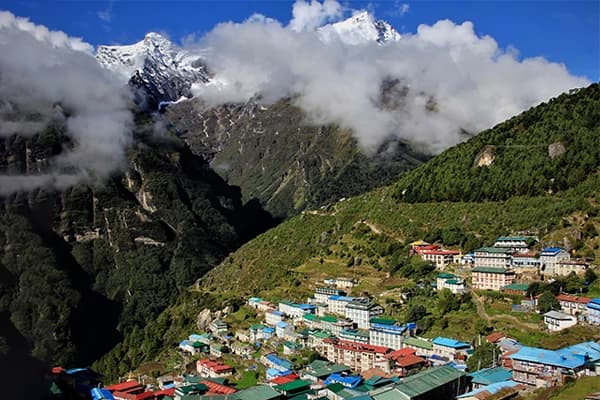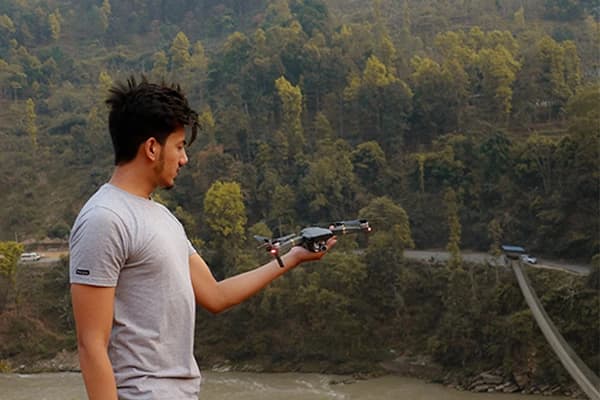Mythological Origins of Sakela Parva 2025
The Udhauli and Ubhauli festivals are deeply rooted in the Kirat community’s mythology, cosmology, and agricultural traditions. It showcases the community’s ancient traditions and agricultural lifestyle.
When there is talk about the Udhauli and Ubhauli parva in Nepal's history, the story of the legendary figures Paruhang and Sumnima always comes forward. According to the Kirat community, the Paruhang (a deity residing in heaven) once saw Sumnima (a beautiful goddess of the earth) and fell in love with her.
To express his affection, Paruhang crafted a beautiful comb and gifted it to Sumnima. This romantic gesture led to their marriage. This marriage symbolized the union of heaven (Paruhang) and earth (Sumnima).
However, after the birth of their four children, Paruhang mysteriously left his family. According to the story, he left to meditate by the Dudh Koshi River and at the top of Mount Everest. He meditated for years on the top of the world (everest peak).
At the time, the Sumnima somehow managed and handled the situation; she continued to care for her children. During her search for food, she discovered a powerful creeper plant. By consuming the plant, she gained strength, happiness, and the power to speak only the truth.
When Paruhang realized that nothing can be compared to his family and the ultimate happiness and meaning of life is with family. After realization, he returned to Sumnima. He explained to the summa about his journey. After the reunion, Sumnima danced with joy, and this dance became the origin of the Sakela dance.
This story of love, separation, and joyful reunion of Paruhang and Sumnima is celebrated through ritual dance and communal worship.
Cultural and Social Importance
Both festivals have equal cultural importance in Nepalese society. The festival symbolizes the Kirat people’s respect for nature. It is the way they say thank you to nature. The celebrations also foster cultural transmission from the ancestors to the younger generations.
The Parva features the popular Sakela dance. The dance serves as a means of honoring nature and reinforcing cultural identity among participants. It is a true reflection of ancestral traditions and showcases the connection to their environment.
The Udhauli festival is celebrated for the good harvest. The people thank Mother Nature for the plentiful harvest and pray for continuous prosperity. As the festival days are near, the people harvest the crop and sum up the farming.

While the Ubhauli festival celebrates fertility, growth, and prosperity. In this festival, the people pray for a good harvest and community well-being. As the festival arrives, people prepare for the new farming season and the arrival of the summer season.
Furthermore, festivals give the platform for cultural expression. Kirat subgroup members come together to celebrate their shared heritage. This festival gathering promotes brotherhood and fosters a sense of unity within the community.
The Udhauli and Ubhauli festivals play an important role in bringing the peoples of Kirat society together as well. Members of diverse clans and tribes within the Kirat community who were separated due to migration or employment come together.
These festivals provide the platform to alleviate social tensions, conflicts, and stress within households and communities. People participate in communal rituals, forgetting the misunderstandings and reinforcing the social bonds.
Rituals and Celebrations of the Udhauli and Ubhauli Festivals
There are various rituals associated with the Udhauli and Ubhauli festivals in Nepal. The key rituals are described below.
-
Cleaning and decorating homes
The first ritual of this Kirati festival is cleaning the homes and surroundings. This is the first step of preparation for welcoming prosperity. This ritual is similar to the rituals of the tihar festival celebration in nepal.
After cleaning, the people decorate their spaces with colorful patterns made from colored powders called rangolis and oil lamps (Diyas). This ritual is performed to invite good fortune into their homes.
-
Offerings to Nature and Harvest Gods
In this ritual, people make offerings of rice, grains, fruits, and vegetables to deities associated with agriculture. These offerings are made with prayers.
It is done to express gratitude to the deities for their blessings, health, prosperity, and successful harvest.
-
Performing Pujas (Prayer Ceremonies)
This is the main part of the festival. It is conducted at home or in community spaces. During these ceremonies, families honor their ancestors and seek blessings for protection during the winter.
Some families may also perform the animal sacrifices (mostly chickens) as part of their rituals.
In some households, women begin the festival with fasting. It is done as a form of spiritual cleansing. During the fasting, the women avoid impure foods and substances.
-
The Migration of Birds Ritual (Symbolic)
The festival is also linked to the migration of birds. So, as a part of rituals, some communities release pigeons during the rituals. It is done to represent the bird's transition from higher altitudes to warmer regions as winter approaches and from lower altitudes to colder regions as summer approaches.
After the rituals and ceremonies, it’s time for celebrations. People lit the bonfires with wood. And then they perform the traditional dance called the Sakela Naach around the bonfire.
During the celebrational dance, the participants wear colorful ethnic attire such as chhit ko guneu for women and Daura Suruwal for men. They engage in the lively dances accompanied by traditional music played on instruments like drums (dhol) and flutes.
A community feast is an important part of the festivals. A communal feast features traditional dishes like Dhunge Khule (a dish made with millet), rice, meat, and sweets like jaggery treats. All the dishes are prepared from freshly harvested ingredients.
-
Final Prayers and Closing Rituals
After all the celebrations and rituals of the Udhauli and Ubhauli festivals, participants offer the final prayers at the local temple. This concluding ritual is done to seek protection for their community throughout the winter.
Udhauli and Ubhauli Parva Across Nepal
Udhauli and Ubhauli parva are most prominently celebrated in eastern Nepal. You can see the celebrations taking place throughout the country wherever Kirat communities reside.
Major gatherings take place in the public spaces like Tudikhel in Kathmandu and various districts such as Ilam, Panchthar, and Tehrathum. The regional celebrations see large gatherings in areas like Khotang, Bhojpur, Dharan, and Dhankuta too.
This Nepali festival celebration showcases cultural heritage and gives a platform for social harmony among diverse ethnic groups within Nepal. Nowadays, people are focusing more on the communal gatherings rather than the elaborate rituals.
Tips for the tourists attending Udhauli and Ubhauli festival celebrations
- Respect local cultures and traditions.
- Understand the festival celebrations and activities associated with it.
- Expect a variety of cultural performances, including the Sakela dance.
- Engage with local customs by observing rituals and participating in dances if invited.
- Dress appropriately. Wearing traditional attire can enhance your experience.
- Always ask for permission before taking photos of individuals or sacred rituals.
- Plan your travel and pack warm clothes for the colder temperatures.
- Purchase handmade crafts or food items from local vendors to support the community.
Combining festivals with trekking
Combining Udhauli and Ubhauli festival 2025 participations with adventurous activities like trekking and hiking is a unique idea. You can experience the rich cultural heritage of the Kirat communities while enjoying the stunning natural landscapes.
You can plan your trekking during the Udhauli and Ubhauli festivals in the popular trekking regions like the annapurna region, the everest region, and the langtang region. You can experience the unique blend of culture and nature during the trek.
Some of the popular treks you can plan include ghorepani poonhill trek, the langtang valley trek, the mardi himal trek, the upper Dolpo Trek, and the pikey peak trek. These are the places where you can engage in the trekking along with the festival celebrations.
FAQs
1. What is Udhauli Parva?
Udhauli Parva is one of the Indigenous festivals of Nepal, celebrated by ethnic groups such as the Rai, Limbu, Yakkha, and Sunuwar. The term “Udhauli” means “downwards" in English. It signals the seasonal migration of people, animals, and birds from the higher altitudes to the lower altitudes as winter approaches.
2. What is the difference between Udhauli and Ubhauli?
Both Udhauli and Ubhauli festivals are popular festivals celebrated in Nepal. The only difference is that the festival in Nepal, Udhauli, celebrates the end of the harvest season. While Ubhauli marks the arrival of the new season for the Kirat Community.
3. Is Yomari Punhi on the same date as Udhauli Parva?
Yes, the Yomari Punhi is on the same date as the Udhauli Parva, on Dec 5, 2025. Yomari Punhi is a popular festival celebrated by the Newar community of Nepal to celebrate the rice harvest and the full moon.
Conclusion
The Udhauli and Ubhauli festivals in Nepal are two of the biggest festivals celebrated by the Kirat community. Udhauli marks the start of winter, and people migrate to lower altitudes (cold season), while ubhauli marks the start of summer/planting, and people migrate to higher altitudes.
Happy Udhauli and Ubhauli Parva 2025!






